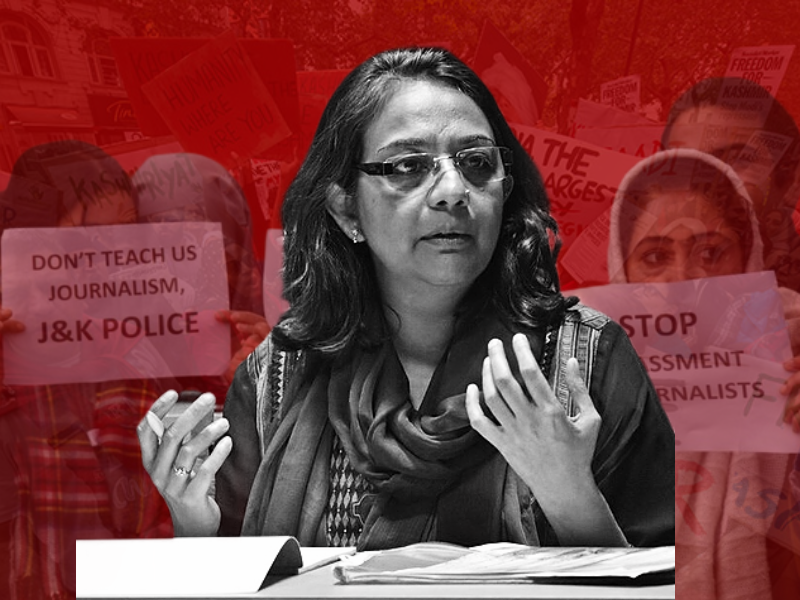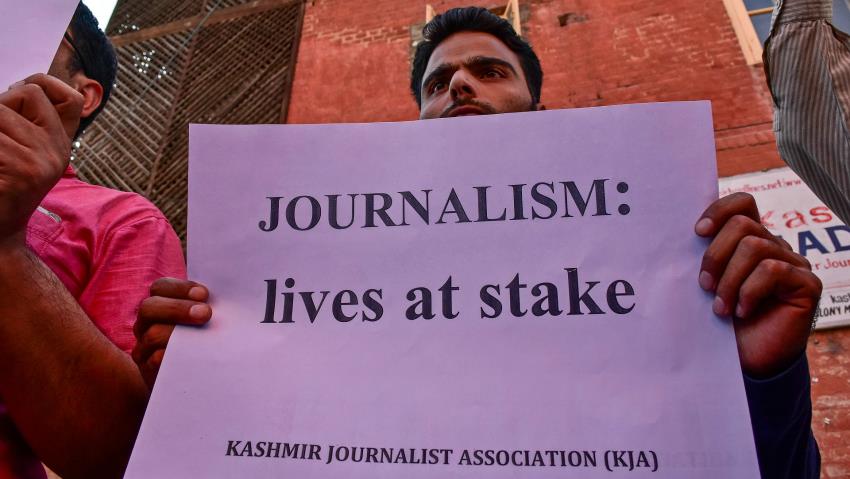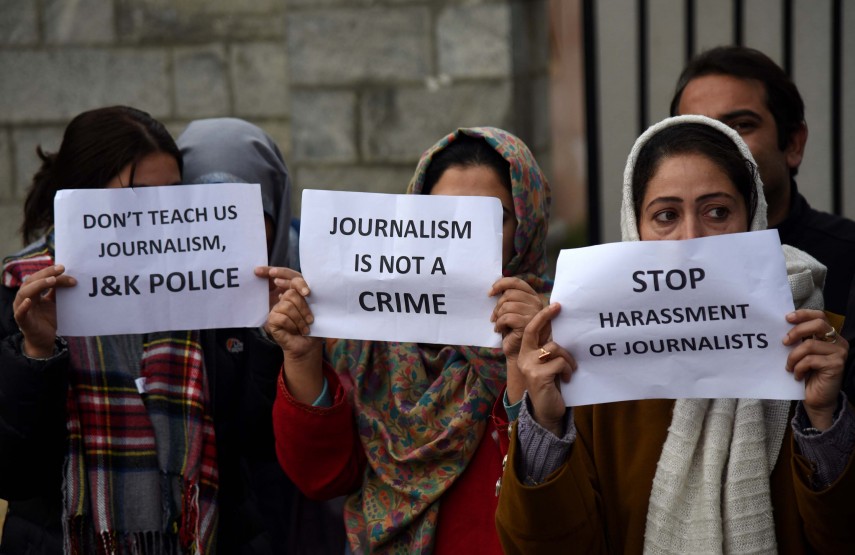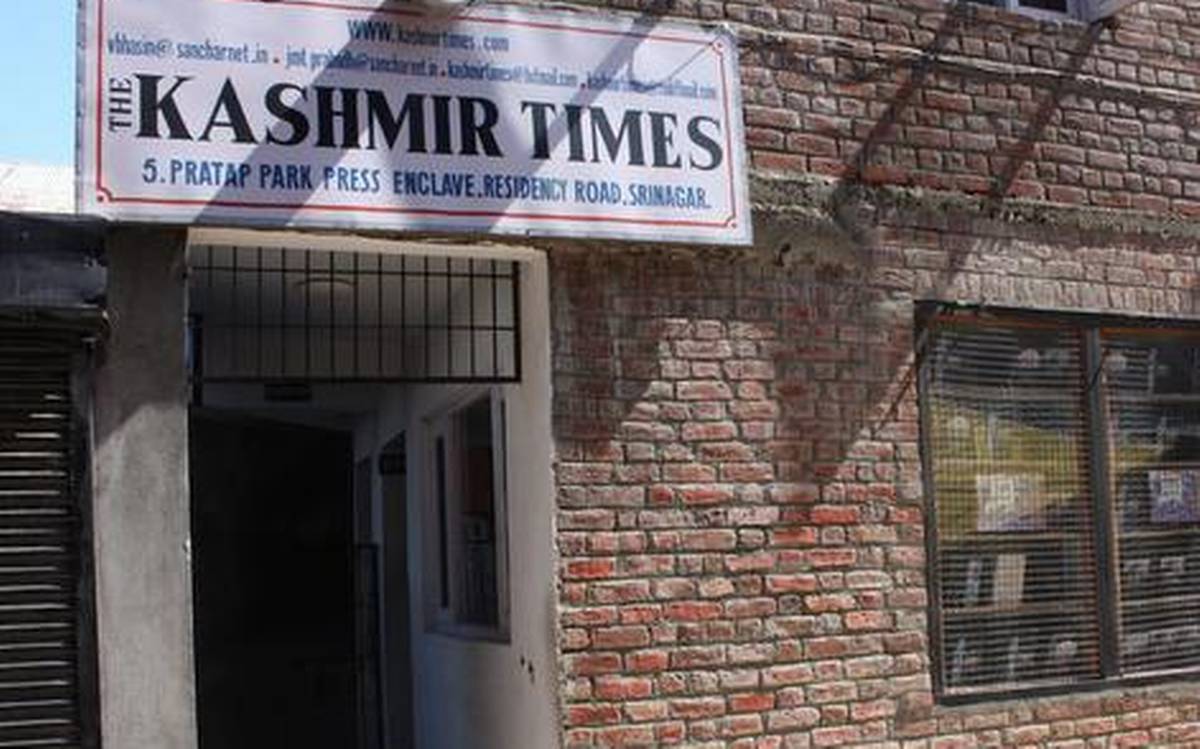In June this year, the Jammu & Kashmir administration announced their latest measure to curtail press freedom and free flow of information in the region — the new Media Policy 2020. Apparently to curb “fake news and misinformation”, the policy gives governments supreme control over any news published in the region and to take criminal action against any media person or outlet that publishes something which the state defines as “untrue” or “fake”. The policy also states that the J & K Department of Information and Public Relations can withdraw and suspend advertisements to the media houses that do not meet “state standards”. Clearly, this means that the administration not only becomes solely authorised to decide & distinguish fact from fiction, but to also use the media simply as “carriers of information” or even as their own mouthpieces. According to media analyst Geeta Seshu, this is the J & K administration’s attempt “to create a sustained narrative in the media about the functioning of the government”.
A rare and seasoned group that has worked under continued state repression for years now, J & K’s journalists don’t consider this as something new but simply an extension of the constraints that had already existed in the region. Around 3 months back, senior journalist and Executive Editor of the widely respected Kashmir Times, Anuradha Bhasin, was evicted from her government-residence in Jammu without prior notice, following which the Srinagar office of the daily was sealed by the state Estates Department. A year before that, Bhasin had approached the Supreme Court with a petition against the communication blockade imposed as part of the abrogation of Article 370 (Anuradha Bhasin vs Union of India), which the journalist believes irked the state, as part of which they also pulled out their ads from the daily.
Read Bhasin (@AnuradhaBhasin_), a crusader for free press and expression in J & K for years now, discuss these issues and more in this detailed interview with Mukulika R.

Mukulika R (MR): Journalists in Kashmir have lived under severe state repression and militancy for years now. What is different about the new media policy that’s making many of you protest it? Could you briefly also tell us how the relationship of the media & the government historically has been in J & K?
Anurdha Bhasin (AB): The J&K Media Policy rolled out in June 2020 is outlined in a 50-paged Orwellian document that has three main highlights.
1) The government will assume sweeping powers to examine content and identify news items that can be categorised “fake”, “plagiarism”, “unethical”, and “anti-national activities”. Those accused of these offences will be punished.
2) The government would monitor the content published on newspapers and other media channels and would decide what is fake news, anti-social or anti-national reporting. The news organisations involved in “fake, unethical and anti-national” reporting would be de-empanelled and not get government advertisements, apart from facing legal action.
3) The government will do a background check of newspaper publishers, editors and key staff mandatory before empanelling them for government advertisements, apart from security clearance before a journalist is given accreditation.
This virtually means that every word and column written will virtually need a certification of authenticity. The bureaucrats at the J&K government’s Department of Information and Publicity will become the judge, jury and arbiters of not just qualifying news and checking the backgrounds of journalists, but they will also have the powers to press criminal charges against those they feel are playing truant. If this document, that violates the spirit of the Indian constitution and the right to freedom of expression guaranteed by it, becomes the legal bible, media persons will be caught between the options of surrendering and turning themselves into vehicles of the state’s propaganda machinery or standing up in defiance at the risk of being persecuted. What could be construed as “fake news”, “plagiarism” and “anti-national”? Anything and everything!
One must note that these rules were not framed to implement this policy in particular, but were already in place even before it was announced. Several journalists, since August 5, 2019, have been summoned to police and cyber police stations, and been subjected to gruelling interrogation for hours, threatened, intimidated, abused and even beaten up.

Weeks after the COVID-19 lockdown, in April, criminal cases were lodged against senior journalist and commentator Gowhar Geelani, photojournalist Masarat Zahra and reporter Ashiq Peerzada. Geelani and Zahra were booked under the anti-terror Unlawful Activities (Prevention) Act (UAPA) for their Facebook posts, but the cases did not mention any particular post. On April 20, Peerzada Ashiq, who’s the Srinagar’s correspondent of The Hindu, was accused by the police of reporting “factually incorrect” news that “could cause fear or alarm in the minds of the public”. The case did not cite the law that was being allegedly violated, but a criminal case was lodged against him nonetheless.
These cases are in line with the character of the government, even though the policy was formally announced two months later in June, 2020. Before the official policy was announced, a climate of fear had already been prepared, creating a psychological impact and putting the media almost in a state of freeze. Last year’s communication ban went on for several months, forcing media persons to operate out of the government created Media Facilitation Centre, which bought their work under state surveillance. Journalists in the region have been operating in an exacerbated climate of fear since then.
State and the Media
Kashmir’s media has operated under severe stress and strain forever — particularly in the last three decades of military conflict, negotiating the challenges and threats of novel methods of gags, censorship and physical intimidation from state and non-state actors. Newspapers have been banned from time to time by both the state and militant groups. Media persons have been jailed, physically attacked and killed. But today, the challenges exist at multiple levels of logistical impediments and the lack of freedom to operate, bringing all voices to an unprecedented freeze and pushing information into a black hole, from where its recovery is increasingly becoming irreversible. Poor resources and limited budgets, in view of advertisement bans have hit media houses badly in the last decade, further limiting their power of negotiating with the present challenges.
Watch here | Freedom of press J & K Media Policy: In Conversation with Geeta Seshu
At the highest echelons of power, intolerance to freedom of the press is deepening and unlike the rest of India, the Kashmiri journalist is grappling with two extra phenomena – firstly, the threats of militants and angry mobs, and second, the demonisation of Kashmiris in national imagination of “anti-national”. The information vacuum has fuelled rumours, myths and untruths to take firm root, enhancing the sense of intimidation and fear in Kashmir.
The silence of information is not born in a vacuum — it’s linked to local conditions and the widening domain of fear that exists between the might of the government to detain anyone (including three former chief ministers) without a charge, and also some faceless, non-state actors.
MR: The media’s role is indispensable in democracies. Apart from potential negative impact on press freedom, how do you see the new policy affecting the society and people of J & K in general in the coming years?
AB: The purpose of the press is to give voice to the disempowered and speak truth to power. Truth cannot be replaced by silence or half-truths — this would be a lie and serve no purpose for the work we do. However, if the government is uncomfortable with every word, image or comment, then the media is reduced to the publicity wing of the state.
The media is the watch-dog of democracy and it’s their duty to hold the government accountable for their actions. Here, it is the reverse, and this has a telling impact on the nature of democracy and also the fundamental rights of the people. The media, which acts as a bridge between the government and the public by giving voice to the marginalised and the unheard, has mostly been reduced to a shadow. For instance, human rights are rarely spoken about by the media in the region — so much so that in August 2020, a Muharram procession was attacked by police with bullets and pellet guns, injuring and blinding several people. The reportage of the incident, however, was very muted.

Forget arrests, torture and human rights violations, last year, the absence of reportage on the impact of the stringent lockdown on the day-to-day lives of ordinary humans, the devastating blow to the health and education sectors, and the silence that was so pervasive, ended up legitimising the myth of “normalcy” that the government was labouring to showcase.
MR: How much have things gone from bad to worse now? Could you describe what a Kashmiri journalist’s daily life is like in the Valley these days, in the light of the abrogation, the aftermath of the communication blockade, and related developments?
AB: Vulnerability has definitely increased, leading to extreme stress and anxiety. In recent months, two young journalists died of sudden heart attacks. Is there a correlation? I don’t know, but this question certainly merits a deeper probe.
The climate of fear, intimidation, and the sheer powerlessness of the journalist in the face of stringent policies, criminalisation of reporting and commenting mean that journalists are forever caught in a grip of dilemmas — between maintaining professionalism and risking lives, between missing the deadline and doing a story without the government’s version (when officials become inaccessible) or going ahead and risking being slapped with “fake news” charges.
MR: The office of Kashmir Times was sealed and you were evicted from your government-residence in October this year. Could you give us an update?
AB: Kashmir Times has initiated legal proceedings in the court of the Deputy Commissioner, Srinagar (instead of Judicial Courts, all disputes regarding govt property are first heard by Deputy Commissioners. This was amended by the J & K government in 2018), for restraining the Estates Department, Government of J & K UT from locking and sealing our office (located in Quarter No: 9 – Pratap Park, Residency Road, Srinagar) on September 14th. The hearing of the case was listed for October 19th and a stay order was issued by the Deputy Commissioner of Srinagar to not seal it till October 31st, and the case was listed for hearing with directions to the government of J & K UT to file objections against our application.
However, the office was sealed by the Estates Department on October 19th itself. The restraining order was served to the Estates Department by the office of the Deputy Commissioner, Srinagar and personally handed over to the Estates Officer, Srinagar by the Kashmir Times staffer. Despite this, the Estates Officer refused to remove the lock from the main entrance of the office building. The Deputy Commissioner of Srinagar has not attended the court since then after the case was listed almost every week. As such, the Estates Officer, Srinagar or the government of J & K UT have not filed their objections till December 2nd, when the hearing was scheduled to take place.

As far as the government accommodation in Jammu that I was using as my residence is concerned, it was handed over to new allottees even before my eviction. This was done along with my assets, and for several weeks together, there was a complete refusal to hand over my belongings back to me. When I finally managed to get them, many things were found stolen and damaged, including valuables. I challenged both my illegal eviction without any due process and the fresh allotment. The matter is sub-judice at the court.
MR: What according to you are the values that the Kashmir Times has historically upheld, which made it encounter something as appalling from the powers that be? Could you give some examples of your stories which have upset the state most?
AB: The founder-editor of Kashmir Times was my father, Ved Bhasin, and he has been the inspiring force that has kept the organisation struggling against the many odds, while also adhering to the foundational principles and ethics of journalism. Protecting constitutional democracy and humanism, in accordance with Ved Bhasin’s vision of an egalitarian, just, peaceful and democratic society, have been its core ever since its inception. Our endeavour is to speak for the most marginalised and unheard and ask tough questions to the powers that be.
Our entire body of work, since decades, has upset successive regimes. But in more recent times, our criticism of the dilution of Article 370, reports on human rights, the eviction of tribals from forests, and the change in land laws have probably irked the government the most. My articles in various other publications — on the multiple negative impacts of the last years’ changes, particularly on the BJP’s design to alter the demography of Jammu and Kashmir, making Jammu a pawn on the Kashmir chessboard, critique of the new media policy, and the new form of unannounced censorship, as well as co-opted silence of the media — may have upset the state. I also received some feedback that they weren’t happy when I went to court last year against the communication ban.
MR: J & K is considered by many as a laboratory for state repression, surveillance and abuse of power — acts likely to be repeated elsewhere in the country. Yet, solidarity from the mainstream Indian media has not been up to expectations.
AB: There is only a small section of the Indian media that is critical of the condition of Kashmir. By and large, solidarity is not only missing, but there is a vast section of the media involved in constantly demonising Kashmiris and peddling lies that even blur the lines between an ordinary Kashmiri and a terrorist. This is because even the most liberal of Indian media organisations and individuals, who are otherwise quite professional, often view Kashmir from the prism of nationalism and territorial security. It appears as though their professionalism somehow ends where Kashmir begins. This is also why most of Indian media have refused to speak for the victimisation of ordinary Kashmiris and the persecution of its own media. Harsh and undemocratic methods of control are justified in the name of security and a misplaced notion of nationalism and jingoism.
MR: We’ve seen how ‘fake news’ has been a pretext for many governments globally to curb media freedom. How do you draw a line between curbing fake reporting and protecting media freedom, or should there be a line at all? Do you think the state should have any say in media matters?
AB: Fake reporting is an issue for all of us, especially in the age of smartphones, when all it takes is a click to enable circulation among tens of thousands in a few seconds. The task in front of the professional media, therefore, is to sift fact from fiction. Unfortunately, many leading media outlets are known to have relied on fake news and some of them, even after they are caught, offer no clarification.

Curbing fake media is important, but this should not mean curbing press freedom. In fact, if the state is empowered to deal with fake media or any other problems with respect to the media, there is little scope for fair decisions. This is because the decisions would then be guided by the vested interests of the people in power, their likes and dislikes. In most likelihood, this would turn out to be a weapon against media houses that are critical of the government in question.
Therefore, tackling fake media requires multi-pronged strategies. We need journalists to be better trained in detecting fake news through technology and the government should immediately come out with clarifications and set the records straight. Besides this, citizens should also be trained to identify and differentiate fact from fiction and this training should perhaps begin at the school-college level. This education should be on how social media messages are to be received, shared and forwarded responsibly, and how news must be read intelligently and interrogatively. Lastly, if at all there is a need for a regulatory authority, it must be an autonomous body composed of experts, and not bureaucrats.




